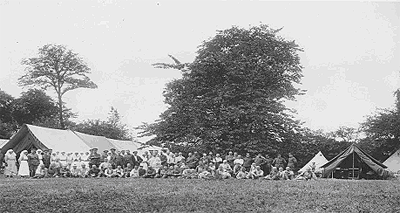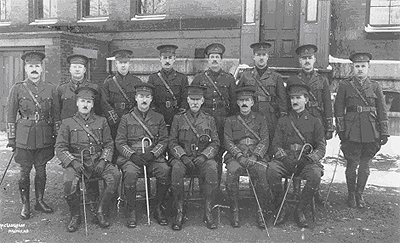 |
| Stationary Hospital No. 7 in France. |
Walking into the Henry Hicks A&A building, it’s hard not to be struck by all the names of Dalhousie’s war dead listed on bronze plaques: “In proud remembrance of our classmates who gave their lives in the great war, 1914-1918.”
During the First World War, the discussion around the Dalhousie boardroom table wasn’t if the university was to become involved – it was how.
As soon as the war was declared, Dalhousie set about training students as officers for the Canadian military. The South-End Skating Rink was taken over for drills and a building at the technical college was transformed into a shooting gallery. At the convocation ceremony on February 26, 1915, 12 students got their Bachelor of Arts degrees and immediately graduated to the front. Even students who stayed behind were expected to do “patriotic undertakings.” They volunteered with YMCA to entertain troops wintering in the city or they worked with the Red Cross.
Dalhousie was also eager to contribute by outfitting its own field hospital overseas. It made offers to the government in the Spring of 1914 and a year later, but was rebuffed. Meanwhile, McGill, University of Toronto and Queen’s University were setting up overseas, and Dalhousie persisted. The university’s third offer was accepted. As supplies for the hospital were being gathered, Dalhousie’s leaders fanned out through the province to raise money. They set a goal of $10,000 and ended up raising more than $17,000 to outfit the hospital.
 |
| Lt. Col. John Stewart and officers with Stationary Hospital No. 7. |
Stationary Hospital No. 7 was comprised of 162 staff members, including Dalhousie professors, senior medical students and nursing sisters. They sailed from Saint John, N.B. on December 31, 1915 on the Metagama, arriving in Plymouth, England on January 10, 1916. “Life on board was not at all dull!” reports an unidentified writer in the Dalhousie Gazette. Hospital staff watched wrestling matches and concerts and stood for inspection each morning. They also kept fit by doing exercises—“which made many men pant and puff and swear as no company drill on the old Dalhousie campus had ever done.”
At first, the hospital set up in Shorncliffe Hospital in Kent, treating the sick and wounded sent back from the front along with locals. Doctors and nurses attended to the legless, armless and those suffering shellshock: “All are but wrecks of their former physical manhood.”
Later in 1916, No. 7 was moved to France and set up a tent city in Le Havre, a location of “rare beauty,” said an account submitted to the Gazette. Later still, they moved to an old chateau near Armentires and began treating German prisoners of war as well as Canadian soldiers.
Dalhousie President Arthur MacKenzie pushed hard to get his medical faculty back after the armistice was signed on November 11, 1918, but Dalhousie medical officers and nurses only returned to Halifax months later, in May of 1919. Colonel John Stewart, who was in charge of No. 7, became the Dean of Medicine in 1919 and remained in that position until 1932.
According to the President’s Report of 1915-16, 446 Dalhousians “answered the call of the flag.” George William Stairs was the first “Dalhousian to fall for Empire.” Graduating with distinction in 1908, he was killed in action during the second battle of Ypres on April 24, 1915. At that point, 49 students and alumni, including two Rhodes Scholars, had lost their lives. Twenty-three were decorated for distinguished service.
Said the report: “One cannot feel that the ideals of the university are high, and that the pride she has taken in her sons is justified when one considers such a record as this.”
With thanks to archives specialist Kathryn Harvey and librarians with University Archives.
